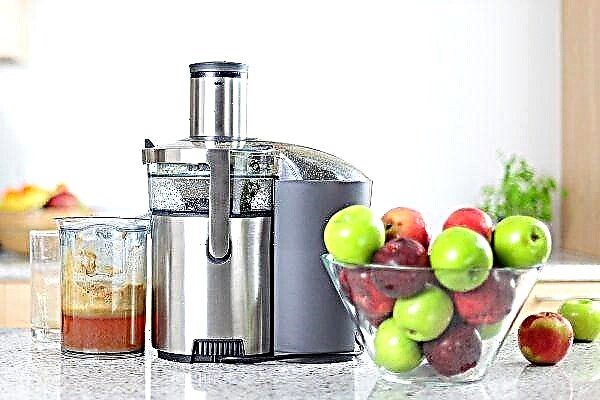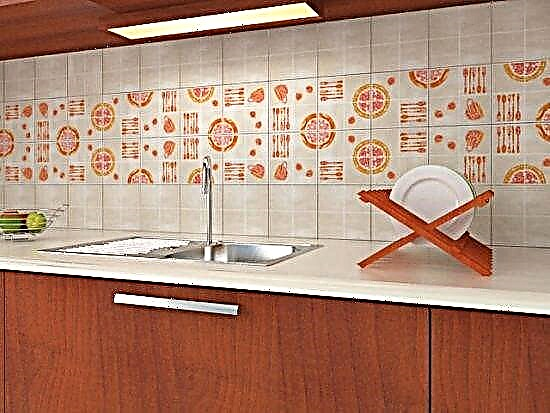As you already understood, juicers are different. In particular, there are 3 main species, and those, in turn, are already divided in their category. And now we will briefly, but informatively, tell about each of them. And we will start with the most common models - centrifugal.
Centrifugal Juicers
They are called so, because the juice is squeezed into them thanks to centrifugal forces. Their design is simple: there is a centrifuge inside - a disk with filters on the sides. When activated, this disk rotates at a very high speed (from 10 to 40 thousand revolutions per minute), and there are knives on its surface. As soon as a fruit or vegetable gets on this disk, it is ground in mashed potatoes, which, in turn, is pressed against the walls of the filter by centrifugal forces (due to very fast rotation). The filter passes liquid (i.e. juice), but not the cake. Next, the already squeezed juice is collected in a container, after which it is ready for consumption.
Models of this type have one feature: when squeezing juice, they heat it, which is not very good. Firstly, warm, heated juice is not very tasty, and secondly, during the extraction process, a reaction of iron and oxygen occurs, due to which oxidation is carried out. There is nothing wrong with oxidized juice, but at the same time it has a cloudy tint and a specific taste (some even like it). This is especially true for apple juice, because it is apples that contain a lot of iron.
Centrifugal juicers come in two types: with a conical and cylindrical separator. Models with a conical separator throw the cake into a separate container, making the juicer easy to clean. After receiving the juice using a juicer with a cylindrical separator, the cake remains inside the structure, which complicates the washing process. However, the latter (with a cylindrical separator) produce more juice from the same amount of fruit, so they are better, although less convenient in terms of ease of use.
The disadvantage of such models is (in addition to rapid oxidation) is also a large noise level, so when choosing, be sure to look at the noise characteristics in the documentation. If the noise is within 30-45 dB, then this is quite normal.
Screw Juicers
This is the second type of model that is less popular. Here, the technology and design are fundamentally different: the juice is extracted using screws, not a centrifuge.
We can say that between these two types of models for juice production there is a real war for market leadership, and therefore ...
These models have much lower power (200-300 watts versus 800-1000 watts), but they are not inferior in performance. They are less noisy, one might even say quiet, and ways to get juice even of berries with seeds and herbs (typical for some models). It is generally impossible to try to squeeze juice from berries with seeds in centrifugal models, because this may damage their disc and clog the filter severely.
Another characteristic advantage of screw devices is the much lower contact of juice with air during its extraction. Also, it does not heat up, due to which the useful properties of the product are preserved. And since there is less contact with air, the juice oxidizes much more slowly, but to say that oxidation does not occur at all, of course, is impossible.
Everything sounds simply fabulous, until it comes to the shortcomings of these models. The first of these is the limited choice of products. For example, you cannot get juice from apples of soft grades. You just get mashed potatoes (well, or baby food) instead of pure juice. Of course, this juice will be more due to the content of cake in it. So, if you plan to choose a juicer for apples of hard varieties, which you can’t count in your garden, you can stop at the screw model. And if you intend to get juice from soft varieties, then buy centrifugal juicers.
By design type screw devices are: vertical, horizontal. The latter are very specific, they squeeze juice from various greens and grains very well, but they cannot get juice from fruits or vegetables. It is better to have a vertical model at home, because it is more universal.
Citrus Juicers
Everything is clear from the name here - these devices are intended for squeezing juice from oranges, lemons, etc. Ordinary citrus models do poorly, so it’s best to have 2 types of juicers at home:
- Citrus,
- Universal (screw or centrifugal).
By design, they are not much different from each other. The only thing: some have a lid for fixing and indenting the fruit, others do not (here you have to press the fruit onto the rotating cone with your hands).
That's all. There can be nothing complicated in terms of choosing a juicer. Finally, we would like to recommend centrifugal models to you - they are more universal than the others.
Electric
Such devices are driven by an electric motor housed in the housing. Human participation is minimal and limited:
- product tab
- power on
- if necessary by pushing the products with a pusher,
- service after operation.
Power provides them with a relatively high speed, the ability to quickly process large volumes. But they:
- warm up and require frequent interruptions in work,
- often fail due to engine problems,
- consume electricity, which means they require even small, but additional costs.
Hand held
Driven by the physical strength of man. They do not differ in high performance, spinning occurs slowly, especially when working with a large number of products. The lack of an electric drive does not allow to leave the mechanism working and tackle other problems. But:
- the owner of such a model does not have to pay an additional fee for the consumption of electricity,
- cold pressing allows you to save the beneficial properties of processed vegetables and fruits,
- the device does not make noise
- provides a better spin.
Household
Widely represented on the market in a wide variety of options. Designed for everyday use at home. Designed for an average urban family of three to four people. Can be used for processing fruits collected from a small summer cottage. At a cost affordable to the average average buyer. Unsuitable for processing products on the scale necessary for food service or industrial production.
Appointment
In most cases, household juicers are positioned as universal. However, the designation declared by the manufacturer is not always supported by the relevant technical specifications. For example, low-power devices will not work well with solid fruits. As part of this classification, they are divided into devices for:
- citrus fruits
- processing of solid fruits,
- stone fruit.
Station wagons
These are powerful, multi-speed devices with wide functionality. They easily cope with fruits of any kind. Depending on the number of nozzles, they can regulate the volume of foam and pulp, completely cut them off, perform the functions of a meat grinder, produce sausages or homemade noodles.
They are distinguished by high spin quality and increased productivity. But at the cost of such devices are expensive and do not always correspond to the budgetary capabilities of most consumers.
Manufacturers
The origin of the juicer and its brand do not belong to the classification grounds. But when choosing, this is no less important parameter than power or a list of functions. A recognized brand allows you to count on high quality performance and durability of the device. It promises to save money during operation, use without frequent breakdowns and contact service centers.
Among the manufacturers of such devices, the most popular products are:
- German Bosch
- Dutch Philips
- French Mulinex,
- British Kenwood
- Japanese Panasonic.
From manufacturers of the CIS countries, a good reputation has:
- Belarusian MEZ with its Rossoshanka,
- Russian "Neptune" with the same juicer,
- Russian "Spectrum Instrument".
The list can be continued, but these brands are enough to select the necessary device that is optimally suited to the purpose, the preferred performance characteristics and the capabilities of the family budget.
For citrus
If you want to drink fresh fruits only from citrus fruits, then such a device will be very useful. The cone-shaped nozzle, driven by a motor, squeezes juice from oranges and grapefruits with ease.
The advantages of the devices include:
- Ease of use - just wash and cut the fruit across the lobes. No need to clean or remove bones.
- It has modest dimensions and does not take up much space.
- It works quietly, so you can use it without risk to wake the whole family.
- They are inexpensive.
The disadvantage of this unit is that they are not suitable for other fruits and can only process citrus fruits.
Power and speed
The power and speed characteristics vary significantly depending on the design features of the electric juicer:
- Universal devices are the most powerful: 250 - 2,000 watts. And their juice production rate is very high 10,000 - 13,000 rpm.
- Screw devices are much more “modest” in this regard. Their power does not exceed 150 - 250 W, and the speed is 50 - 800 revolutions.
- Aggregates for citrus are even more economical: 30 - 160 watts. Although they do not need high energy costs due to the fact that citruses are very juicy in themselves and it is easy to get liquid from them without applying titanic efforts.
Many machines are equipped with the same spin speed, but there are models in which their number reaches 9, and they can be changed depending on the desire of the owner and the fruits used. So, for soft ones, low speed is suitable, and for hard ones, an increased speed is necessary. Although, as practice shows, 3-4 modes are enough for any needs and there is no point in overpaying.
Juice tank
Do not chase volumes, since preparing juice in advance is not a good idea: it quickly loses its properties. The size of the vessel should be selected based on the number of people and the amount of drink consumed at a time.
On sale you can find different options: from 350 to 2,000 ml. The former are suitable for one or two people, and the latter come in handy in large families.
The container where the finished drink flows does not have all the appliances. Some devices provide direct feed into the glass.
It is very convenient when there is a scale on the flask that shows how much liquid has already been received. So you can control the amount of drink.
Pulp tank
This is the compartment where the spent cake falls. Not all devices are equipped with it, for example, in centrifugal devices with a round separator, such a separation is absent.
After working off the cake comes into the tank automatically and all that remains for the user after the process is to remove the container and discard the residues.
The volume of the compartment varies from 0.6 to 3 liters. And, as in the case of a juice container, it depends on how much drink you plan to prepare.
Loading hole size
This parameter largely determines how much time you will spend preparing for the spin. If the inlet is narrow, then the fruits will have to be cut beforehand. But a wide throat will allow you to load whole fruits and vegetables into the car.
In most units for the home, the size of the loading channel is from 54 to 84 mm. The most common devices with a tube up to 75 mm - this diameter is enough to put an average-sized apple inside.
Functions
To achieve the best result, manufacturers introduce additional functions into their products, for example:
- Reverse - allows you to scroll the screw in the opposite direction, which helps to separate more fluid.
- Foam Separator - removes the foam that forms during the spin cycle.
- Adjusting the volume of pulp - if you wish, you can get pure juice or a thick, pulp-rich drink.
- Clamping mechanism - relevant for citrus juicers. Useful in order to firmly press the fruit to the cone.
- Pulse mode of operation - the device turns on and off at short intervals - so more juice comes out.
- Anti-droplet system - prevents the remaining drops of nectar from falling onto the table after the work is completed.
- Smooth start of the engine - a gradual increase in the number of revolutions will save from splashing at startup.
The units are also equipped with options that ensure safe use:
- shutdown when the lid is open,
- shutdown when overheating,
- protection against accidental inclusion.
Material
The case can be made of stainless steel or plastic. There is no fundamental difference between them; one should be guided by one's own taste. However, often as an argument for stainless steel devices they call their increased strength. This is indisputable, but you just have to consider that some of the elements are still made of plastic. And to check the impact resistance of the technique is not worth it in any case.
It is much more important what material the mesh in the separator is made of. Plastic is not reliable, so it is better to choose a stainless steel part. For added stability, some manufacturers apply a titanium coating to this element.
Equipment
The more nozzles supplied in the kit, the wider the possibilities for using a juicer, but at the same time the price increases. Therefore, even at the purchase stage, decide for yourself what parts you need, and do not chase a device that can do everything. Usually they either have multiple flaws or are very expensive.
In screw and centrifugal units, the kit always has a pusher for safely moving the fruit along the inlet.
Universal devices are also equipped with a brush for convenient and quick cleaning of the mesh from the remains of pulp.
Citrus juicers are often complemented by cone nozzles of various diameters for fruits of different sizes.
In which store to buy
Like any other equipment, buying a juicer is from a reliable seller who sells goods from an official manufacturer. If you are wondering where to buy the device via the Internet, then pay attention to the sites (links lead directly to the selection of goods):
In order to choose the right juicer and subsequently not regret the perfect purchase, you need to answer the main question: for what purposes do you need it?
- If you are going to pamper yourself in the morning with orange and grapefruit fresh, then a citrus device is definitely suitable for you.
- If you want the maximum variety of tastes, but you are not going to process large volumes, then you better buy a universal device.
- If you need to process the crop or you are a fan of unusual cocktails with herb juice, then opt for a screw machine.
Which juicer did you choose for yourself? Share what your choice is justified.
For different fruits and berries
By type of products used, juicers are divided into the following types:
Any design is suitable for citrus fruits, because oranges and lemons are quite soft and have a watery structure.
The power of the device is practically not important, the main thing is to pay attention to the quality of the device and give preference to trusted companies.
To extract juice from solid fruits, a household juicer must have high productivity. Optimum power is considered to be from 200 to 250 watts. A weak device will not cope with a carrot or an apple, a stronger one will consume more electricity.

For stone fruits, a screw juicer is needed. It uses a round sleeve that separates the bones from the pulp.
This is especially true for berries like mountain ash, sea buckthorn or gooseberries, which are not possible to extract bones from with your hands (unlike, for example, cherries). In a regular juicer, they will quickly clog the strainer and can ruin the mechanism.
Centrifugal and screw
Rotary models are based on centrifugal force. Inside the container is a knife, which, rotating at high speed, grinds the fruits. The pieces are pressed against the walls, juice is squeezed out of them and flows into a glass. The cake remains on the filter. Fruits placed in a centrifugal juicer must be pre-cleaned and free of seeds and cuttings that can clog the filter too quickly.

The cold-pressed screw juicer crushes and grinds fruits and vegetables so that excess oxygen and heat do not interact with them, which contribute to the oxidation of the product and destroy vitamins. They operate at lower speeds and consume less electricity. Modern models allow you to load the whole fruit without first cutting them into small parts. These units, in turn, are divided into single and twin-screw according to the number of internal spirals. The latter are more expensive, but are considered more effective and allow the production of juice of fairly large volumes.

Conclusion
Any juicer, regardless of type, will be a great gift, as more and more people are trying to lead a healthy lifestyle. An inexpensive device allows you to get a natural, rich in vitamins and fiber, and most importantly, a delicious health cocktail that is liked by both children and adults in a matter of minutes.



